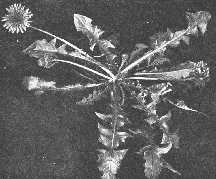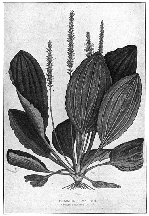DANDELION Taraxacum officinalis
Tools: STRONG DIGGING FORK, ground knife, anvil pruners, pressure water,
Whole Dandelions, Roots and Tops Together
 Whole dandelions are best dug when the plants are obviously lush, green and actively growing, as opposed to late fall, winter or early spring's straggly appearance, especially of the greens. I prefer to dig them before the summer solstice in the spring and after the autumn equinox usually through October. I use a full-strapped very heavy duty digging fork which can be used as a prying bar beyond simple digging, in tough turf or unruly rocky ground. Tediously I cut a squarish 12" deep plug and lift it carefully out and break the soil away from the roots with utmost care to minimize tearing or breaking the plump brittle roots. The broken roots are a mixed blessing; each little piece may grow an entire new dandelion plant; each broken end on the harvested portion will exude some of the precious hepatophilic latex. I try to dig dandelions on cool doudy days to reduce heat and drying damage. If not entirely possible, I take an extra sheet or two along for impromptu shade/cover for plants already harvested. So far, whole dandelion plant harvest has been exclusively for the fresh plant extract medicinal trade. Since they are to be shipped fresh live, great care is taken to ensure that freshness. Not only do I dig on cool cloudy days, but also early in the morning to reduce plant stress. The plants are pressure washed with pure, unchlorinated water in the shade and allowed to drain before packing and shipping.
Whole dandelions are best dug when the plants are obviously lush, green and actively growing, as opposed to late fall, winter or early spring's straggly appearance, especially of the greens. I prefer to dig them before the summer solstice in the spring and after the autumn equinox usually through October. I use a full-strapped very heavy duty digging fork which can be used as a prying bar beyond simple digging, in tough turf or unruly rocky ground. Tediously I cut a squarish 12" deep plug and lift it carefully out and break the soil away from the roots with utmost care to minimize tearing or breaking the plump brittle roots. The broken roots are a mixed blessing; each little piece may grow an entire new dandelion plant; each broken end on the harvested portion will exude some of the precious hepatophilic latex. I try to dig dandelions on cool doudy days to reduce heat and drying damage. If not entirely possible, I take an extra sheet or two along for impromptu shade/cover for plants already harvested. So far, whole dandelion plant harvest has been exclusively for the fresh plant extract medicinal trade. Since they are to be shipped fresh live, great care is taken to ensure that freshness. Not only do I dig on cool cloudy days, but also early in the morning to reduce plant stress. The plants are pressure washed with pure, unchlorinated water in the shade and allowed to drain before packing and shipping.Dandelion Tops and Roots Separately
Dandelion Tops Dandelion tops are best harvested by briskly cutting the entire aerial plant off, about 1/2" down onto the crown of the root with a good sturdy ground knife or wide-mouthed anvil pruners, shaking off any dirt, plucking out all of the dead or damaged leaves and spent floral stems, and quickly hanging each individual plant up to dry at 80-90°F until crispy dry. These whole plants are good food and medicine.
Dandelion Roots If I am digging dandelion roots during the active growing season, I will have some greens for every root harvested; these are set aside and treated as above. Dandelion roots dug in the autumn have different though also many of the same medicinal properties, than dandelion roots dug in the spring. Late spring and summer roots can be rather puny and shriveled. I prefer plump sweet roots dug in the autumn and early winter. Scorpio and Pisces are the favorite time frames for me. I like digging on a cool cloudy or lightly raining day so the soil does not dry onto the roots while waiting to be washed away. Most dandelions grow in full sun and suitable shade may be quite distal. Before drying, the roots are pressure-washed with pure water coarsely in a pile and then finely individually by hand and allowed to drain for up to an hour on screens. Roots thicker than an inch in diameter are cut in half longitudinally before being placed on the drying racks. Otherwise, dandelion roots are dried whole without cutting at 80-100oF inside until crispy hard-crack dry, and then placed in airtight, opaque containers.
It has been my curious observation that large roots can usually be selected in the dormant season by observing the extent of leaf margin dentition: the more deeply notched the leaf margins and the more pointed the small dormant leaves' tips, the larger the roots. Dig on. Any rapid or unexplained decline in dandelion populations should be viewed with utmost alarm.
PLANTAIN Plantago major & P. lanceolata
Tools: Ground knife or anvil pruner 5-Gal harvest bucket.
 Plantain leaves are very fragile once harvested even though quite tough in the ground, withstanding repeated impact trauma and related physical abuse. They are best used fresh. I harvest them by cutting 1/2" below the top of the corm so that all of the leaves remain attached to the corm; this reduces harvest shock. The cutting is done with a ground knife or anvil pruner, this activity dulls blades quickly. The cut plants are delicately handled and placed corms down in 5-gallon plastic buckets. If it were over 50oF I would put an inch or so of water in the bottoms of the collecting buckets; the buckets are kept shady and cool. I prefer to harvest on a cool cloudy day before 9 AM in one of the spring months. A little rain will not hurt. Dried plantain leaves are medicinally much less effective than fresh leaves. Cut plantain corm bases left in the ground tend to regrow successfully. Plantain seems to be a very successful abundant wild plant. Its hardiness may assure its further survival.
Plantain leaves are very fragile once harvested even though quite tough in the ground, withstanding repeated impact trauma and related physical abuse. They are best used fresh. I harvest them by cutting 1/2" below the top of the corm so that all of the leaves remain attached to the corm; this reduces harvest shock. The cutting is done with a ground knife or anvil pruner, this activity dulls blades quickly. The cut plants are delicately handled and placed corms down in 5-gallon plastic buckets. If it were over 50oF I would put an inch or so of water in the bottoms of the collecting buckets; the buckets are kept shady and cool. I prefer to harvest on a cool cloudy day before 9 AM in one of the spring months. A little rain will not hurt. Dried plantain leaves are medicinally much less effective than fresh leaves. Cut plantain corm bases left in the ground tend to regrow successfully. Plantain seems to be a very successful abundant wild plant. Its hardiness may assure its further survival.
No comments:
Post a Comment